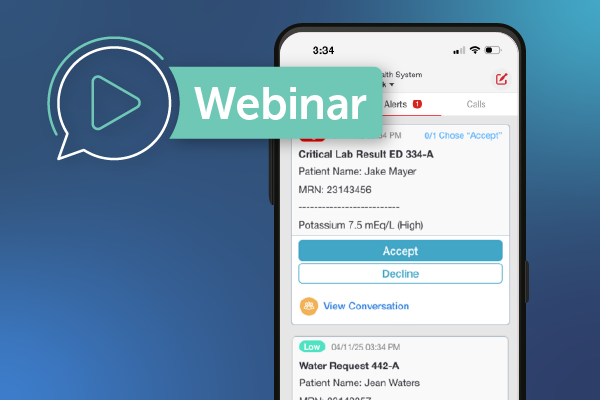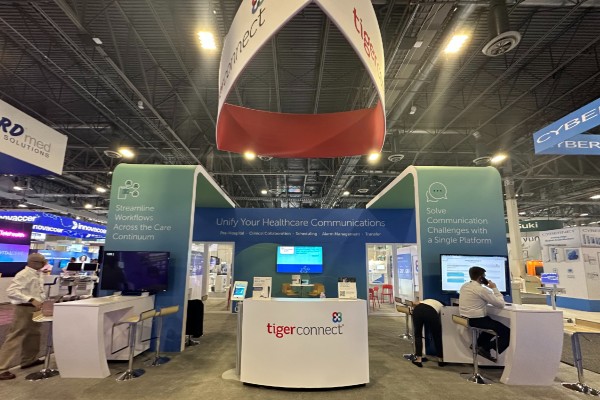
Investing in Patient Satisfaction to Reduce Churn
It’s critical for healthcare facilities to remain financially stable in order to provide essential medical services to the patients in their community. Much of the revenue that hospitals receive comes from new and recurring patient visits[1]. Therefore, the ability for hospitals to survive relies heavily on patients’ loyalty and their willingness to recommend the facility to others.
Some patients may decide to leave the care of the hospital, and this is referred to as patient churn. A patient leaving may be due to a household move, insurance changes, or a condition being successfully treated and cured. But sometimes patients leave due to dissatisfaction with care or interactions with staff. A large concern for healthcare facilities is to discern what factors are in their control and how they can improve in order to reduce patient churn.
One significant way to increase patient retention is by investing in ways to improve patient satisfaction. It’s estimated that dissatisfied patients are four times more likely than satisfied patients to leave care within six months[2]. This can be detrimental since one dissatisfied patient that decides to leave can cost a facility up to $200,000 over the course of a lifetime[3].
There are four main factors by which patient satisfaction can be evaluated[4]:
- Care
- Empathy
- Reliability
- Responsiveness
Following are a few methods hospitals can employ to target the four factors above and reduce patient churn.
1. Communicate Better with Patients
An analysis of patient satisfaction in the healthcare setting reported that satisfaction highly correlates with the ability of care providers to explain procedures and treatments[5]. Short visit times can often hinder effective communication between the care provider and patient. For instance, patients may not have adequate time during their visit to ask important questions about post-visit care that they must carry out at home, such as taking prescription medications. Studies show that 1/3 of patients do not take medications as prescribed, which can lead to setbacks in treatment progress and patient dissatisfaction[3]. Therefore, it’s important for care providers to be able to communicate with patients in between appointments.
Modern mobile technologies such as patient texting and telehealth can help increase patient loyalty by facilitating better healthcare communication. By using these technologies, physicians can give follow-up care instructions to the patient and can promptly address any questions or concerns a patient may have about treatment. Fast response times show empathy for the patient’s needs and will likely leave a good impression. Further, using a secure telemedicine platform assures patients that their sensitive private information will never be compromised.
2. Minimize Wait Times in the Office
According to a survey administered by Weatherby Healthcare, patients spend 1/3 of their visit time waiting to be seen[6]. Some of these long wait times can be attributed to previous patients forgetting about appointments or showing up late to them. Utilizing automated appointment reminders can help prevent missed appointments and shorten the time patients are waiting to be seen.
3. Automate Lab and Medication Orders
Submitting handwritten requests for labs, tests, or prescriptions is time-consuming and inefficient. Sometimes these orders get lost by the patient and need to be reordered, costing extra time and money for the hospital. The adoption of technologies that allow for the automation of these orders can solve these issues and reduce the time it takes for patients to receive tests or medications. Further, some electronic prescribing systems are capable of detecting which drugs interact with each other, which can reduce human error. It has been shown that the capability to order tests and labs through electronic means has the ability to boost patient satisfaction by 8-11 percent because of reduced delays in care[7].
4. Improve Accessibility to Patient Information
There are many facets to a patient’s health; therefore, some patients may be cared for by several specialized medical team members. As a result, it may be a challenge to retrieve patient test results, lab reports, and records that were performed in different areas of the hospital or even different facilities in a timely manner. Electronic health record (EHR) integration allows for these records to be saved and accessed electronically, which saves time for both the physician and patient during visits that are already too short. In fact, integrating data from all aspects of a patient’s healthcare profile can improve patient satisfaction by 10-15 percent[7].
5. Facilitate Collaboration Between Healthcare Providers
When a patient is treated by a large team of healthcare professionals with different specialties, there needs to be an efficient way for them all to communicate in a timely manner, especially if they work in different areas of the hospital[4]. Modern clinical communication and collaboration tools that use real-time messaging can facilitate the inclusion of other care team members in the discussion of a patient’s course of treatment. Care team members can track the progress of a patient and can be alerted immediately if a prompt action is necessary in critical situations. This can ensure that all care professionals are on the same page when it comes to the patient’s treatment.
6. Reduce Fragmentation
A patient may interact with up to 50-60 employees during their stay at a hospital[3]. During a stressful time such as a hospital visit, people hope for a comforting, familiar face to make them feel at ease. Providing more customer service and reducing the number of people a patient sees can allow for the hospital to appear more coordinated and help improve satisfaction.
7. Pay Attention to Aesthetics
One survey reported that 78 percent of patients cared about the design, cleanliness, and comfort of a facility[6]. These data indicate that people remember how a facility made them feel during their time there. With this in mind, hospitals should ensure that they have a professional but inviting environment with good housekeeping.
8. Educate Patients Outside of the Office
It has been noted that 59 percent of physicians wish they had more time with patients, while 33 percent of patients wish they had more time with their provider[6]. Physicians can increase time with patients by following up with them outside of the office visit. Providing educational information to patients via email or a quick phone call can help, but perhaps the easiest means is to send secure texts to patient smartphones. Providing post-visit communication suggests that a physician cares, and it can also result in better treatment outcomes, reduced hospital readmittance, and more satisfied patients[3].
9. Manage Patient Expectations
Patient satisfaction is higher when the quality of care exceeds expectations during a hospital stay[5]. Hospitals can manage patient expectations before their arrival by sending out pamphlets or letters – via mail, email, or text – that outline what will happen during their stay and the roles and responsibilities of the employees they will encounter.
10. Obtain Data from Surveys
Obtaining patient feedback is critical for hospitals to maintain patient satisfaction. Patients want to see that hospitals are listening to and addressing their concerns. Hospitals can receive feedback in a number of ways, such as questionnaires, follow-up phone calls and emails, online reviews, and suggestion boxes[3]. Digitally documenting responses makes it possible to track trends in complaints and then find solutions. Communication technologies can monitor electronic system usage and show teams what aspects of communication they can improve.
11. Encourage Patients Between Appointments
Hospitals can promote patient loyalty by communicating equipment enhancements and staff achievements, or by offering continued health tips. Encouraging patients to come back by mailing, emailing, or (judiciously) texting updates on new medical procedures and technologies is a good strategy that hospitals can use to retain patients[4].
12. Evaluate Current Procedures
By evaluating the workflow a patient goes through from intake to discharge, hospitals can catch certain aspects of the process that may result in patient dissatisfaction. For instance, improving communication among care teams can mean the staff is prepared before a patient arrives or is notified in advance of a planned discharge, optimizing the process and reducing wait times. Even having a checkout step that allows the patient to schedule a future appointment may be critical for retaining some patients[8].
How TigerConnect Can Help
Focusing on patient satisfaction can reduce patient churn, thereby improving a healthcare organization’s financial stability. In addition, current incentive programs from the Centers for Medicare and Medicaid Services redistribute money to hospitals based on performance, so patient satisfaction is more important than ever.
Many of the methods discussed above rely on modern communication technologies that make healthcare visits and follow-ups more efficient for both patients and providers. TigerConnect delivers a comprehensive platform of solutions that optimize communication, collaboration, and workflow, thereby increasing both staff and patient satisfaction and improving a healthcare organization’s bottom line. Request a demo today.
Sources:
- Mehta SJ. Patient Satisfaction Reporting and Its Implications for Patient Care. AMA J Ethics. 2015;17(7):616-621. Published 2015 Jul 1. doi:10.1001/journalofethics.2015.17.7.ecas3-1507
- Poulos GA, Brodell RT, Mostow EN. Improving quality and patient satisfaction in dermatology office practice. Arch Dermatol. 2008;144(2):263-265. doi:10.1001/archdermatol.2007.58
- Prakash B. Patient satisfaction. J Cutan Aesthet Surg. 2010;3(3):151-155. doi:10.4103/0974-2077.74491
- Yousefi, K., Kargari, M. Patient Relationship Management Method, an Approach toward Patient Satisfaction: A Case Study in a Public Hospital. International Journal of Travel Medicine and Global Health. 2014; 2(1): 11-17.
- Abramowitz S, Coté AA, Berry E. Analyzing patient satisfaction: a multianalytic approach. QRB Qual Rev Bull. 1987;13(4):122-130. doi:10.1016/s0097-5990(16)30118-x
- Hanover Research and Weatherby Healthcare. The portrait of a modern patient. 2017. Available at: https://3d48d5394e5c26eba97c-c2cd0437cc11d2b508db932a8299b2de.r74.cf1.rackcdn.com/media/images/PortraitModernPatient_Executive_rw_v4_f.pdf. Accessed December 14, 2020.
- Roham M, Gabrielyan AR, Archer NP. Predicting the impact of hospital health information technology adoption on patient satisfaction. Artif Intell Med. 2012;56(2):123-135. doi:10.1016/j.artmed.2012.08.001
- McDermott, E. They’re just not that into you: why patients churn (and how to stop them). 2017. Available at: https://www.webpt.com/blog/they-re-just-not-that-into-you-why-patients-churn-and-how-to-stop-them/. Accessed December 14, 2020.
Learn more about Clinical Collaboration Software Platform, Resident Scheduling Software, Physician Scheduling Software, Alarm Management & Event Notification Software & Patient Engagement Software.
Featured Resources
Related Articles














